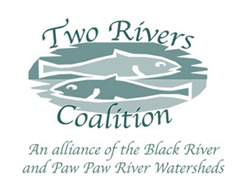Home>The Watersheds>Paw Paw River Watershed>Ryno Drain
Ryno Drain Sub Watershed
From watershed management plan:
Priority areas were identified in the watershed based on lands that are contributing, or have the potential to contribute, most of the pollutants impacting water quality. By identifying priority areas, implementation can be targeted to the places where the most benefit can be achieved. Three different types of areas were prioritized in the PPRW – protection, agricultural management, and urban management.
The far west end, near Lake Michigan, of the Ryno Drain Sub Watershed is a Medium Priority Protection Area while the river corridor is High. If not preserved or at least managed properly, these areas have the potential to contribute large amounts of pollution, as well as disrupt hydrologic patterns in the watershed.
Protection Areas- The prioritization of protection areas is based on the amount of natural land cover (habitat), groundwater recharge potential, intact wetland functions, the presence of high-quality water bodies and development pressure. Section 8.1 of the management plan provides more details. The following tasks should be focused in the high and medium priority protection areas.
- Enact/improve water quality protection related ordinances
- Protect wetlands
- Enact ordinances protecting riparian buffers
- Develop and enact design and maintenance standards for road stream crossings
- Enact a septic system time of sale inspection ordinance
- Identify and correct problem road/stream crossing sites
- Protect sensitive lands
- Improve soil erosion and sedimentation practices and regulations (building construction site practices and regulations)
- Improve zoning maps to locate high density or intensive uses in appropriate areas
- Identify and correct failing septic systems
The central area around Coloma and Watervliet is a High Priority Urban Management Area while the area around Hartford is a Medium Priority and suspected to contain most of the urban related pollutant sources impairing or threatening water quality in this area.
Urban Management Areas - The prioritization of urban management areas is based on significant water body impairments, amount of urban land cover and problems identified by MDEQ staff, MDNR Fisheries staff, Van Buren County Drain Commissioner or through the volunteer inventory process. Section 8.3 of the management plan provides more details. The following tasks should be focused in the high and medium priority urban management areas.
- Utilize stormwater best management practices (road/parking lot sweeping, stormceptors, rain gardens, constructed wetlands, vegetated swales, etc)
- Enact stormwater and post construction control ordinances
- Identify and correct illicit connections or discharges to stormwater system
- Utilize best management practices for road maintenance (such as alternative deicing methods)
- Enact a phosphorus lawn fertilizer ban
- Increase or expand household hazardous waste disposal options
- Distribute spill kits
- Properly maintain and design municipal sewer system infrastructure
The eastern end of the Ryno Drain Sub Watershed is a High Priority Agricultural Management Area and suspected to contain most of the agricultural related pollutant sources impairing or threatening water quality in the area.
Agricultural Management Areas - The prioritization of agricultural management areas is based on significant water body impairments, estimated pollutant loadings (SWAT model), amount of agriculture land cover and problems identified by EGLE staff, MDNR Fisheries staff, Van Buren County Drain Commissioner or through the volunteer inventory process. Section 8.2 of the management plan provides more details. The following tasks should be focused in the high and medium priority agricultural management areas.
- Utilize alternative drain maintenance/ construction techniques (such as two stage ditch design, natural river restoration techniques - j-hooks, cross vanes, etc)
- Restore riparian buffers and stabilize eroding streambanks
- Restore wetlands
- Prevent/limit livestock access (fencing, crossings structures, alternative water sources)
- Install agricultural BMPs (filter strips, no-till, cover crops, grassed waterways, etc)
- Protect wetlands
- Expand disposal options for agricultural chemicals
- Develop and implement manure management plans
- Utilize soil testing to determine appropriate application rates for fertilizers and pesticides
- Utilize integrated pest management
- Construct secondary containment facilities for chemical/fuel handling areas
- Improve and/or enforce septage waste disposal regulations

![Paw Paw River in the Spring [Click here to view full size picture] Paw Paw River in the Spring [Click here to view full size picture]](media/pages/tn_paw_paw_river_in_the_spring_720x192a.jpg)